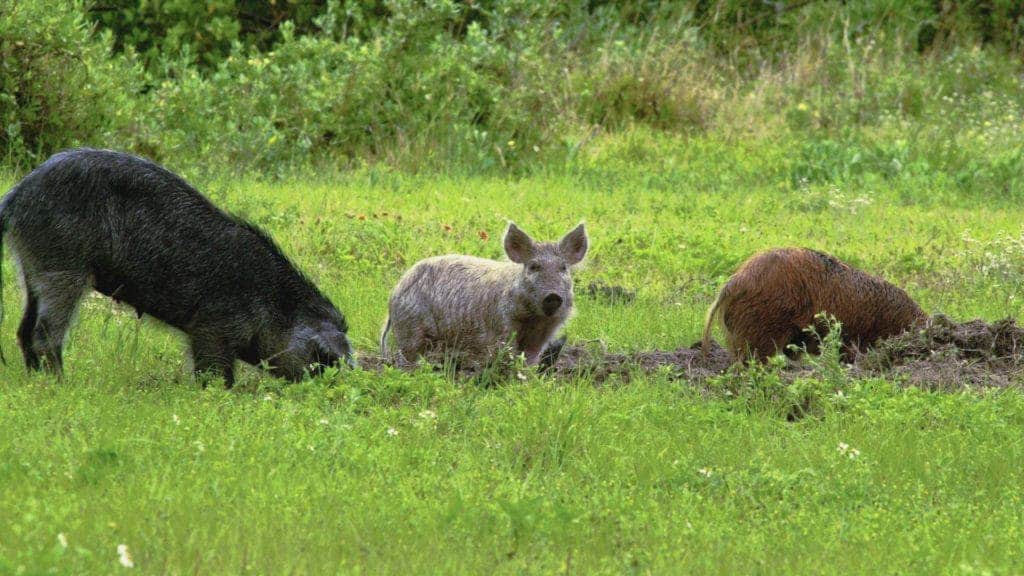
Feral pigs are among the most damaging invasive species out there. Like tractors plowing a field, these wild hogs use their powerful snouts to uproot carbon trapped in the soil. In a new study, researchers in Australia and New Zealand have calculated the extent to which this behavior is contributing to carbon emissions for the first time, showing that wild pigs across the world release around 4.9 million metric tones of carbon dioxide annually, as much as about 1.1 million cars.
“When soils are disturbed from humans ploughing a field or, in this case, from wild animals uprooting, carbon is released into the atmosphere,” said Dr. Christopher O’Bryan, lead author of the new study and a postdoc at the School of Earth and Environmental Sciences at the University of Queensland.
“Since soil contains nearly three times as much carbon [as] the atmosphere, even a small fraction of carbon emitted from soil has the potential to accelerate climate change.”
Feral swine use their super-tough snouts to plow through the soil in search of their favorite foods, roots, fungi, and invertebrates. This excavating behavior disturbs the soil at a depth of around 5-15 centimeters, which is about the depth reached during crop tilling by farmers. When excavated soil is exposed to oxygen in the atmosphere, microbes grow much faster, breaking down organic matter containing carbon, which is then released into the atmosphere as a greenhouse gas.
O’Bryan and colleagues at the University of Queensland and the University of Canterbury in New Zealand devised a computational model that indicates wild pigs are currently uprooting an area of around 36,000 to 124,000 square kilometers in environments where they are not native. Most of the soil damage and carbon emissions occur in the Oceania region due to the disproportionate distribution of wild pigs there, as well as the higher than usual amount of carbon stored in the region.
The researchers employed existing datasets on wild pig numbers and their locations, which they used to simulate over 10,000 maps of wild pig density. Previous estimates of wild pig soil damage based on research in the Americas, Europe, and China were plugged into the model to calculate the amount of soil area disturbed by the invasive animals.
A feral swine time bomb
Wild pigs (Sus scrofa) are native to Europe and some parts of Asia. They were first brought to the Americas by early Spanish explorers. Today, wild pigs can be found in 45 states in the US, expanding from 17 states just three decades ago. As many as nine million feral swine can be found across the U.S. In fact, they can be found on every continent except Antarctica, making them one of the most widespread invasive species.
This rapid expansion of wild pigs has been sometimes called a “feral swine bomb”, in reference to their out-of-control breeding. In the U.S. alone, feral pig populations are responsible for an estimated $2.5 billion in damage, mostly by inflicting damage to farmers’ crops, as well as attacking calves, lambs, and livestock.
Wild pigs also have a huge negative impact on biodiversity. One study found that they directly threatened 672 vertebrates and plant species native to 54 countries.
“This is an enormous amount of land, and this not only affects soil health and carbon emissions, but it also threatens biodiversity and food security that are crucial for sustainable development,” O’Bryan said.
But ultimately, it is humans who are responsible for this damage since it’s us who introduced feral pigs to different countries and allowed them to multiply in such great numbers. This new study adds yet another reason to start investing more in wild pig population control, showing that allowing invasive pigs to expand in areas with abundant soil carbon will only make our global heating problem worse.
“Because wild pigs are prolific and cause widespread damage, they’re both costly and challenging to manage,” said Nicholas Patton, a Ph.D. candidate at the University of Canterbury and co-author of the study.
“Wild pig control will definitely require cooperation and collaboration across multiple jurisdictions, and our work is but one piece of the puzzle, helping managers better understand their impacts.
“It’s clear that more work still needs to be done, but in the interim, we should continue to protect and monitor ecosystems and their soil which are susceptible to invasive species via loss of carbon.”
The findings appeared in the journal Global Change Biology.


